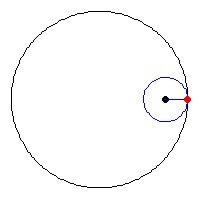Astroid

The equation above shows an equation of an astroid with positive constant , find the area enclosed by the astroid in terms of .
This section requires Javascript.
You are seeing this because something didn't load right. We suggest you, (a) try
refreshing the page, (b) enabling javascript if it is disabled on your browser and,
finally, (c)
loading the
non-javascript version of this page
. We're sorry about the hassle.
S u b s t i t u t i n g x = a ( cos θ ) 3 & y = a ( sin θ ) 3
A r e a = ∫ y d x
x = a ( cos θ ) 3
d x = 3 a ( cos θ ) 2 × − ( s i n θ ) d θ A r e a = ∫ a ( sin θ ) 3 × − 3 a ( cos θ ) 2 × ( sin θ ) d θ
A r e a = − 3 a 2 ∫ ( sin θ ) 3 ( cos θ ) 2 × ( sin θ ) d θ
T o t a l A r e a e n c l o s e d ( A ) = 4 × − 3 a 2 ∫ 0 π / 2 ( sin θ ) 4 ( cos θ ) 2 d θ
∫ 0 π / 2 ( sin θ ) 4 ( cos θ ) 2 d θ = Γ 2 4 + 1 Γ 2 2 + 1 × 2 1 × 1 / Γ 2 4 + 2 + 2
∫ 0 π / 2 ( sin θ ) 4 ( cos θ ) 2 d θ = Γ 2 5 Γ 2 3 × 2 1 × Γ 4 1
∫ 0 π / 2 ( sin θ ) 4 ( cos θ ) 2 d θ = 2 × 3 ! 8 3 × π
A = ∣ − 4 a 2 × 3 × 2 × 3 ! 8 3 × π ∣
A = 8 3 π a 2
Sorry, for the bad latex coding I did with those Gamma functions.